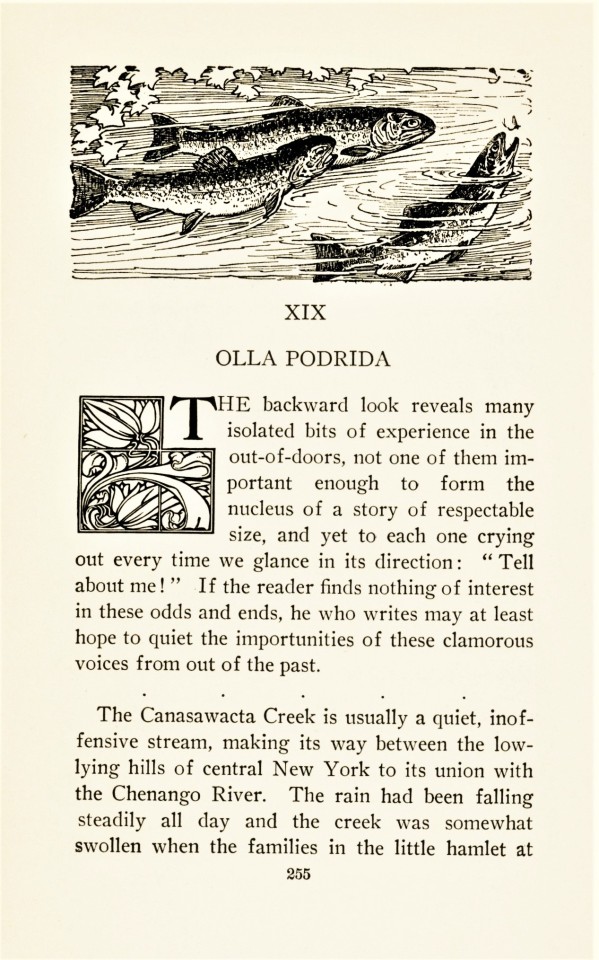#Fleming H Revell Company
Explore tagged Tumblr posts
Photo










Typography Tuesday
Last week, as part of a gift, we received a 1914 copy of Days in the Open by American clergyman and angler Lathan A. Crandall with decorations by the English-born American illustrator Louis Rhead, published in New York and Chicago by the Christian publishing firm Fleming H. Revell Company. We were taken not only by Rhead’s Art Nouveau decorations and illustrations for this volume, but also by how he turned ordinary chapter-opening initial letters into Art Nouveau historiated initials through the use of five different cuts combined with the letters.
Louis Rhead was a prolific designer and illustrator who came from a family of prominent English potters and artists. He was initially trained in art by his father and then in Paris by the neoclassical French artist Gustave Boulanger. When he emigrated to the US at the age of 24, however, he became deeply influenced by the work of Swiss Art Nouveau decorative artist Eugène Grasset. In America, Rhead also became an avid angler, and much of his work after 1900 often involved angling art, as in this publication. Rhead even died in the pursuit of his avocation, dying of a heart attack soon after hooking and then struggling to remove a 30-pound turtle that had been devastating his trout ponds. Now, that’s devotion!
View more posts with historiated initials.
View more Typography Tuesday posts.
#Typography Tuesday#typetuesday#Typography Tuesday#historiated initials#Louis Rhead#Art Nouveau#angling#fly fishing#designers#illustrators#Days in the Open#Lathan A. Crandall#Fleming H Revell Company
81 notes
·
View notes
Text
The temple of truth has never suffered so much from woodpeckers on the outside as from termites within.
— Vance Havner, Pepper ‘n’ Salt. (Fleming H. Revell Company, 1966)
14 notes
·
View notes
Text

AuthorMilligan, Robert H.TitleThe fetish folk of West AfricaOriginal PublicationNew York: Fleming H. Revell company, 1912.
1 note
·
View note
Link
Check out this listing I just added to my Poshmark closet: Inspirational - The Gold Star Family Album.
0 notes
Text
no indecision, a paradox, and nailing him
The opening sentences must be businesslike. There must be no indecision, no “puttering.” The teacher must leap at once to the hand-to-hand combat with the theme which tells his scholars that there’s purpose in it. The opening sentences may sometimes best catch the class by directly addressing one person in it, the most restless, indifferent one, and nailing him. A paradox is good to begin with, some statement of the lesson theme so startling as to spur to discussion, possibly to opposition.
— Amos Russel Wells, chapter 9, “Getting Attention” in his Sunday-school Success : A Book of Practical Methods for Sunday-school Teachers and Officers (Fleming H. Revell Company, Publishers of Evangelical Literature, 1897) : 55 : link (harvard copy) same (LC copy via hathitrust) : link
—
Amos Russel Wells (1862-1933) professor of Greek and geology at Antioch College; later editor of religious publications. wikipedia : link many publications, see his online books page : link
—
The only way always to keep attention is always to be expecting to lose it.
from following chapter “Keeping Attention” p58 : link
0 notes
Link
Check out this listing I just added to my Poshmark closet: RARE Along The Way and Other Poems Robert H Hiller Hardcover 1940 Book Vintage.
0 notes
Photo

Vintage Comic - Archie’s Date Book
Pencils: Al Hartley Inks: Al Hartley Spire / Fleming H. Revell Company (1981)
#Vintage#Art#Illustration#Design#Comics#Spire#Fleming H Revell Company#Archies Date Book#Archie#Archie Comics#Betty And Veronica#Betty#Veronica#Roller Skating#Al Hartley#1981#1980s#80s
17 notes
·
View notes
Photo

ISOLATED COMIC BOOK PANEL #2675 title: ALPHA AND OMEGA #1 - P29:3 artist: AL HARTLEY year: 1978
#1978#Al Hartley#Alpha and Omega#spaceship#shuttle#outer space#future city#comics#Spire Comics#Fleming H. Revell Company#comic books#Isolated comic book panel#sequence
11 notes
·
View notes
Photo

Johnny Pryde. J. J. Bell. New York: Fleming H. Revell Company, (1918). First edition. Original dust jacket.
Wartime story of a “gawky, half-grown Scottish grocer's boy,” and his humorous escapades in love affairs, employment, and family.
14 notes
·
View notes
Text

Mountain Idylls and Other Poems by Alfred Castner King. 1901 Fleming H. Revell Company
7 notes
·
View notes
Text
OVER THE SHOULDER REVIEW: “Conquest of Space” (1955; produced by George Pal; directed by Byron Haskin)
It’s a pity this George Pal-produced gem hasn’t had a Blu-ray release, much less the prestige treatment from a high-end boutique company like the Criterion Collection, possibly because its 1950s sci-fi sensibilities are now regarded as quaint. But the Byron Haskin-directed “Conquest of Space” holds up in our own hobbled age – a time when American exceptionalism has become the exception rather than the rule, and our energies are spent fighting each other over cultural disagreements instead of transcending our limitations in order to extend our reach.
The film is based on a book of illustrations by Chesley Bonestell (co-authored by Willy Ley) – a set of images that inspired screenwriters Philip Yordan, Barré Lyndon, and George Worthing Yates, rather than set out the story as is usually the case when a book finds its way to the big screen. (In this way, “Conquest of Space” is a forerunner to Amazon’s new eight-episode series “Tales from the Loop,” which writer Nathaniel Halpern based on a book of illustrations by Simon Stålenhag.)
The film begins aboard “The Wheel,” a giant orbiting space station that looks like a more primitive (though completed) version of the half-constructed space station envisioned in Stanley Kubrick’s “2001: A Space Odyssey.” The commander of The Wheel, Gen. Samuel Merritt (Walter Brooke), is also the visionary who shepherded construction of the station and saw that it got built. Now The Wheel is the launching point for a deep space mission – not to the Moon, as originally planned, but all the way to the planet Mars. Gen. Merritt’s son, Capt. Barney Merritt (Eric Fleming), is a newlywed impatient to get back to Earth, and to his wife – a desire for which his demanding father has little sympathy. Indeed, Gen. Merritt seems to be closer to no one in the universe than his longtime comrade in arms, Sgt. Mahoney (Mickey Shaughnessy), a lantern-jawed Irishman with a flinty disposition and an appetite for discipline.
Sgt. Mahoney is in charge of a cadre of astronauts who are candidates to fly an experimental new rocket ship to the Red Planet. The men have been specially conditioned for an extended mission in space – a tour of duty in which the physical perils of cosmic rays and meteor showers are very real, though the specter of psychological breakdown is far more likely, and just as deadly. When orders come to man the rocket and take off, Gen. Merritt – named commander of the mission – accepts the offer of service from his son, who’s so proud of his old man that he forgets all about his wife, waiting for him back on Earth. Gen. Merritt gently pressures a select set of “volunteers” to sign on for the voyage. The crew includes technician Jackie Siegel (Phil Foster, later of “Laverne and Shirley” fame), a stereotypical, post-WWII era, wisecracking New Yorker, and also – remarkably, for a pre-“Star Trek” production – a couple of international officers: An Austrian (played by Ross Martin, who went on to co-star in “The Wild Wild West”) and a Japanese engineer (Benson Fong) who acknowledges a recent war of aggression carried out by his countrymen, but notes that a lack of natural resources – now a pressing concern for all of Earth – had much to do with Japan’s military actions.
This all-male assortment was by no means progressive in terms of gender equality. In fact, women only show up for a quick sequence where a variety show, replete with sexy female dancers, is interrupted by a special bulletin announcing the crew’s new mission. A private broadcast carried out at the same time puts the men in touch with the women in their lives, including a devoted mother and an obviously unfaithful fiancée, who is decried by her confounded swain as a “two-timing tomato.”
That male energy extends to the mission itself, which scares up boy’s-own action in the form of improbably spherical, red-hot meteors, a devotional crisis that sees the general descend into zealot madness, and a desperate struggle with a loaded pistol in which, predictably, the sound of a gunshot presages the revelation, a moment later, of a fatal injury to one of the combatants. A crisis involving depleted water supplies and a Christmas miracle round out the ’50s-style story points.
And yet, there’s a spirit of determination and courage to the film that captures something that was once essential to the American identity – something we can only hope, in these latter days, to regain.
“Conquest of Space” is available on DVD and to stream on Amazon in Standard and Hi-Def versions, though to be honest I didn’t really notice much of a difference between the Hi-Def streaming and the DVD versions.
3 notes
·
View notes
Text
A Borrowed Dream: Cimarron Creek Trilogy #2 by Amanda Cabot - Review
A Borrowed Dream: Cimarron Creek Trilogy #2 by Amanda Cabot @RevellBooks @AmandaJoyCabot #lovelylovedayblog #bookreviews #romance #bookblog

A Borrowed Dream: Cimarron Creek Trilogy #2 by Amanda Cabot has an expected publication date of March 20th, 2018 by Fleming H. Revell Company and is a historical romance. Synopsis: Catherine Whitfield is sure that she will never again be able to trust anyone in the medical profession after the town doctor’s excessive bleeding treatments killed her mother. Despite her loneliness and her broken…
View On WordPress
#Amanda Cabot author#christian books#Christian romance#Fleming H Revell Company#historical romance#March 2018 new in books#March 2018 new in romance books#Revell Books#Revell Publishing#romance
0 notes
Link
"On the wedding day of Yanko and Katshka, the silence of the camp is broken by the sound of a screeching violin, followed by the wailing of a clarinet and the grunting of a bass viol. Above the discord of noise made by those instruments is heard the voice of the bridegroom, who leads the dance with the song: 'I am so glad I have you, I have you, and I wouldn’t sell you to anyone.' If you enter the house of the bride, you will find it full of sweltering humanity, all of it dancing up and down, down and up, while the fiddlers play and the bridegroom sings about 'The sweetheart he is glad to have and wouldn’t sell to any one.' Usually the Slav dancers provide the notes and the bank notes also; for at the end of the piece half a dozen stalwart men will throw themselves in front of the musicians, each one of them demanding in exchange for the money tossed upon the table, his favorite tune to which he sings his native song. The result is, half a dozen men, each singing or trying to sing, a different song, all of them pushing, crowding, and at last fighting until in the middle of the room you will find en entanglement of human beings which beats itself into an unrecognizable mass." Edward A. Steiner, On the Trail of the Immigrant (Fleming H. Revell) 1906 All of the performers on this collection were born in the late 19th century in a geographical region bounded east to west by the cities of Budapest to Odessa and north to south by Bucharest to Vilnius - an area a little larger than the combined square mileage of Texas and New Mexico. Around 1900, this region was the intersection of three empires, the Austro-Hungarian, Prussian, and Russian, and today includes all or part of ten countries. The period 1890 to 1930 saw the largest wave of immigrants that the United States has ever seen. By its peak in 1907, nearly 15% of the U.S. population was foreign-born with more than half of foreign-born population having arrived from Eastern Europe. The 1940 U.S. census found that 3,569,360 people living in the U.S. spoke Polish, Russian, Slovak, or Ukrainian as their first language, only 200,000 fewer than the number of people for whom Italian was their native language. This does not count native speakers of Yiddish, Hungarian, Czech, Rumanian, or Slovenian. In a 1982 essay on ethnic recordings in the U.S., Pekka Gronow showed that Columbia Records - one of two major record labels in the U.S. before the Second World War - released 1,856 discs for the Polish, Russian, Slovak, and Ukrainian markets between 1923 and 1952. Add to this thousands more released by Victor and numerous smaller labels, in addition to the other Eastern European ethnic/language groups, and it becomes clear that tens of thousands of performances by Eastern Europeans were released in the U.S. by immigrant performers in the first half of the 20th century, greatly outnumbering those by Southern (Italian, French, Greek, etc) and Northern (German, Danish, Finnish, Norwegian, English, Irish, Scottish) European immigrants. It was in this era that America built its lexicon of racial slurs: polack, hunkie, russki, kike, etc. for the Eastern Europeans, dago, greaser, wop, etc. for the Southern Europeans. The polite press avoided these terms but argued openly about the presumptions underneath them: Are they criminals? Are they mentally inferior? Are they prone to violence and drunkenness? Are they capable of assimilation? Can they be trusted? Social scientists appeared before Congress and argued, using reams of data gathered from prisons and insane asylums, that America’s integrity, our very moral substance, and the future of the country’s “breeding-stock” would be irreparably denigrated by the continued influx of Eastern and Southern Europeans at the rate things were going. In response, in 1924, the Johnson-Reed act was passed, setting quotas on the number of immigrants allowed in based on their nation of origin. Those numbers were designed to reset the ethnic makeup of the U.S. to what it had been before 1890, namely predominantly White Anglo-Saxon Protestant. And those quotas stood for four decades, so that baby boomers lived most of their lives in an America that was more predominantly native-born than their parents or grandparents had. The repeal of the quota system has allowed for increasing immigration over the past forty years to the point that we are, once again, approaching the level of a 15% foreign-born population, and, once again, we are publicly discussing the same questions: “Can they ever be like us?” “Won’t they take over and make a mess of things?” and, worst of all, “Aren’t they basically violent/ criminal/ inferior/ sick/ bad people?” These have always been questions of power and, inherently, questions arising from fear of the diminution of power. The individuals who played on these recordings were predominantly Slavs - Catholic, Greek and Russian Orthodox primarily, possibly some Protestants - as well as Jews and Roma, speakers of a half-dozen languages and ethnic identities who did not always get along with one another. In the U.S., all lived, at the time of these recordings, near the industrial hubs of New York, New Jersey, Pennsylvania, Ohio, and Illinois, where the mines, mills, and factories often worked men six days a week for twelve to fourteen hours. William P. Shriver’s book Immigrant Forces: Factors in the New Democracy (Missionary Education Movement of the United States and Canada, 1913) estimated that the average Lithuanian, Slovak, Polish, South Italian, or Hungarian man over 18 earned $400-$450 a year; 43.5% of the foreign-born population earned under $400 a year. One factory owner said the wage was 16 cents an hour. Asked by an inspector, “how long to they last?” He replied, “Well, they’re no good after forty-five. But you ought to see these Polish women and children work when they’re put to it. Why, a woman and a half-grown girl will feed the whole family, and the man too.. The stockyards are full of them.” The average cost of a record - two songs at a total duration of about six minutes - in the 1920s was between 75 cents and a dollar. Kate Holladay Claghorn’s The Immigrant’s Day in Court (Harper & Bros, 1923) notes: “A clever and heartless scheme, playing upon the immigrant’s homesickness and loneliness was reported to the New York State Bureau of Industries and Immigration [1915]. An offer was made through the foreign press to sell a phonograph ‘with records of your national songs in your own tongue’ on payment of $5 and the balance on small installments. On receiving the machine by express with instructions to collect on delivery the entire amount of the balance. The immigrant, usually unable to pay so large a sum, had to allow the express company to take the machine back, so that the phonograph company retained both the machine and the original payment. A great deal of money was collected in this way. The fraudulent transactions of one man in this line of business was found to have netted him about $125,000 a year, and it was learned that he kept an emergency deposit of $30,000 to be used for legal services should he be arrested. The man, when caught and convicted was fined $750.” Of thee I sing.
4 notes
·
View notes
Link
Check out this listing I just added to my Poshmark closet: Vintage c 1898 Young Men In History small coffee-table book.
0 notes
Photo


Vintage Comic - Hello, I'm Johnny Cash
Pencils: Al Hartley Inks: Al Hartley Spire (1976)
#Vintage#Art#Illustration#Design#Comics#Archie#Spire#Fleming H Revell Company#Hello Im Johnny Cash#Music#County#County Music#Johnny Cash#Al Hartley#Ads#Advertising#House Ad#1976#1970s#70s
97 notes
·
View notes
Photo

ISOLATED COMIC BOOK PANEL #2670 title: ALPHA AND OMEGA #1 - P2:2 artist: AL HARTLEY year: 1978
#1978#Al Hartley#Alpha and Omega#spaceships#shuttle#comics#comic books#Isolated comic book panel#sequence#Spire Comics#Christian comics#Fleming H. Revell Company#outer space
8 notes
·
View notes